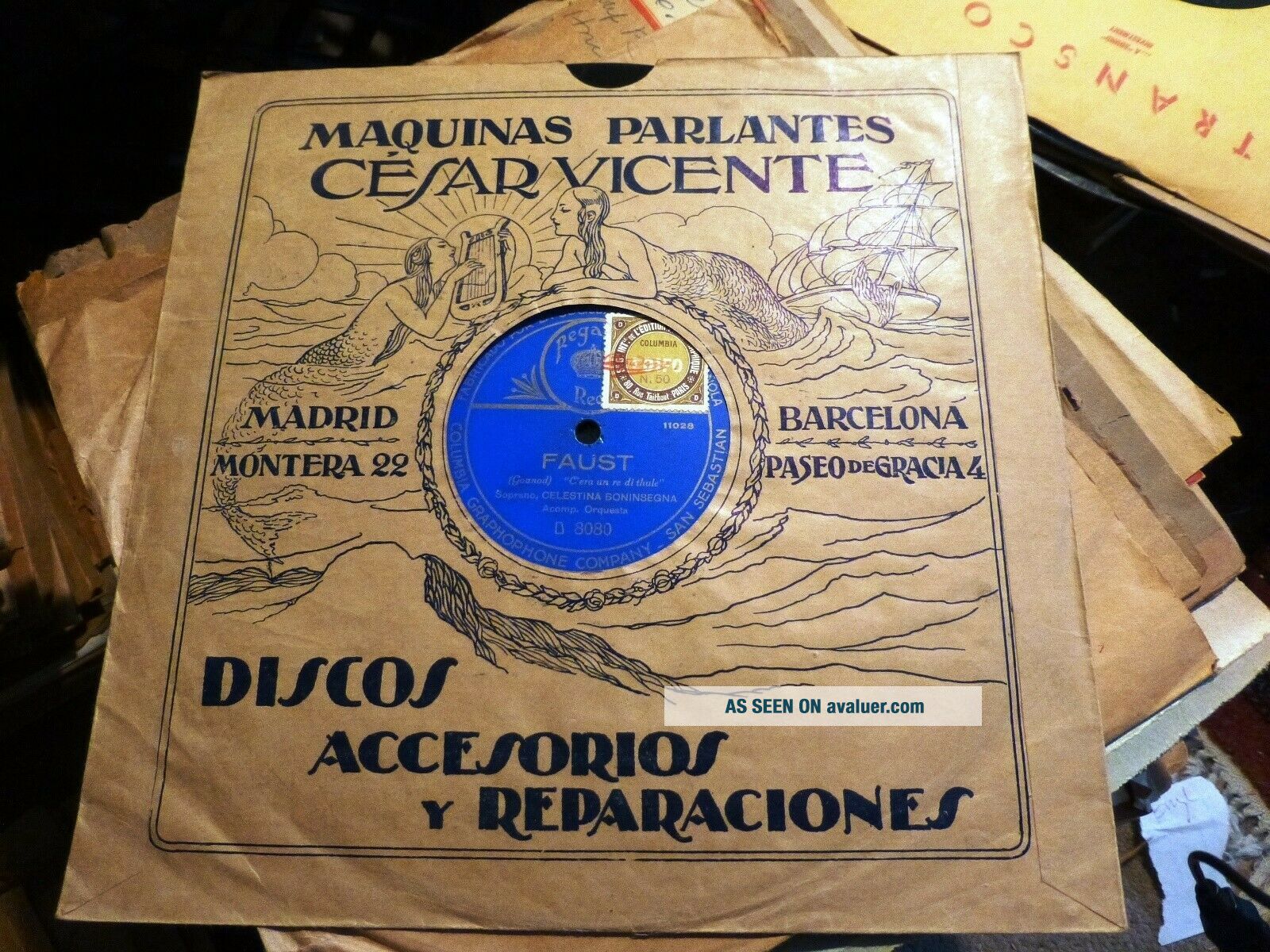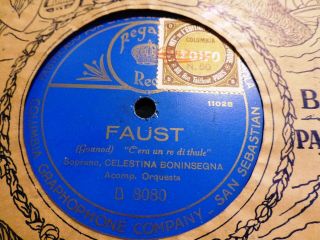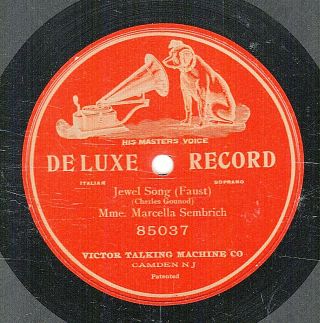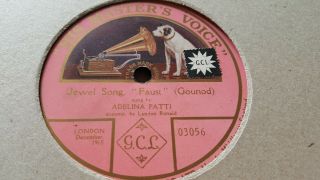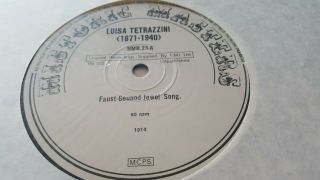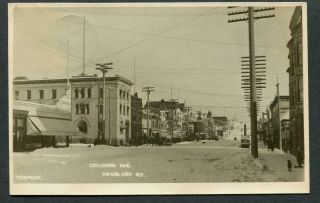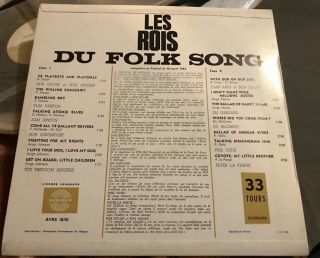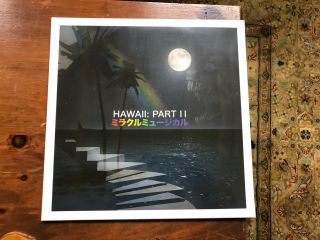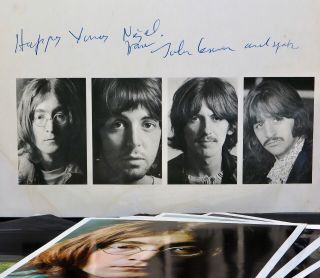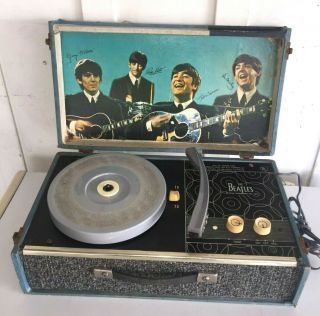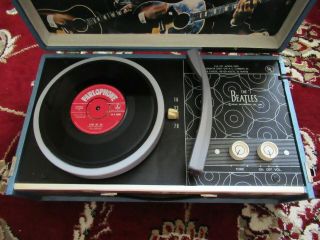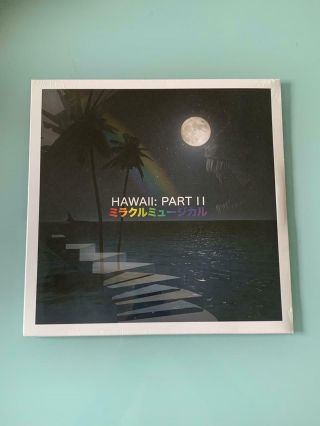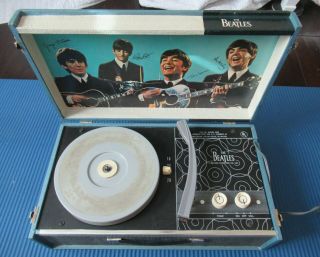1910 CELESTINA BONINSEGNA FAUST JEWEL SONG/ Le Roi De Thule Spanish REGAL RECORD
Item History & Price
| Reference Number: Avaluer:1707842 | Genre: Classical |
| Record Size: 12" | Sub-Genre: Opera |
| Speed: 78 RPM |
HOWEVER in most cases I can get you SIGNIFICANT savings by using other services. Pls contact me for a quote.About 30% less to Canada. Pls ignore international postage displayed in Ebay, rates are too highPlease wait for me to send you an invoice. DO NOT USE EBAY CHECKOUT if you want the lowest possible postage.I am currently selling a series of great Richard Wagner and classic European 78 rpm orchestral recordings on all the great European labels:
Famous Italian Soprano CELESTINA BONINSEGNA on Bravoura Aria w recitative Faust: Jewel Song/ Le Roi de Thule superb Spanish Regal 10" 78 rpm record:
Condition: EXCELLENT close to pristine, lgiht scratch last 1cm of Jewel causes mild ticks plays almost superquiet. A CHOICECOPYCELESTINA BONINSEGNAThis article was originally published in Record Collector and has been amended to include a small amount of additional information and to correct errors which were discovered subsequent to its publication. The great soprano with no career, the great soprano with a minor career, the great soprano who is known only from records; there are so many half truths and untruths about this legendary singer that I asked Larry Lustig if I might write an article about who she was and the shape that her career actually assumed. He graciously consented, and this is the result of my request.I particularly wanted to write about her, because it was she, along with Caruso, who first interested me in 78s. By sheer chance, I heard a recording of her Pace, pace sometime around 1965 and was overcome by both the resonance and the tone of her voice. There was a presence to the singing that I had not heard in any of the others, and I immediately began to search out her recorded legacy. The more I listened, the more fascinated I became, and, at some point about six years ago, I began the research that has finally become this article. Boninsegna was born into a musical and financially comfortable family on 26 February 1877 and, by the age of fifteen was pursuing a course of musical studies at the Pesaro Liceo. She had just finished singing Norina in Don Pasquale at Reggio Emilias Teatro Ariosto and her reception was so encouraging that her parents decided, on the advice of several professional musicians, to afford her the formal training that her obvious talent deserved. The Liceo at that time was directed by Pietro Mascagni, who took an immediate interest in Boninsegna, and who, as we shall see, would have a profound influence on her career. On 29 February 1896 she sang in Rossinis Piccola Messa Sollene at the Liceo with Fiorello Giraud and, a week later, with Alessandro Bonci. Her graduation lesson, on 12 August 1896, drew the following appraisal: "Boninsegna possesses a dramatic soprano voice and sings with great discipline and expression. The voice is of extraordinary equalization". The next night, under Mascagnis direction, she gave a recital at the Salon of the Liceo to a sold out house. Diploma in hand, she secured a contract at Fano, and on 25 December, our dramatic soprano debuted as Gilda in Rigoletto. The reviewer noted that "Boninsegna, who is just beginning her career, warrants encouragement". The Teatro Piccinni of Bari presented her as Marguerite in Faust on 28 January 1897 and the chronicle of that theatre declared her performance "excellent".Another year of study finally allowed her to make that to which she referred as her official debut at the Comunale of Piacenza in December, 1899 as Goldmarks Queen of Sheba , conducted by Bandini. She then appeared in Lohengrin and, near seasons end, in Yanko by Bandini. His opera proved to be less than successful and was replaced with further performances of Lohengrin. She was immediately engaged by the Dal Verme of Milan for Il Trovatore and Ruy Blas and after a summer vacation returned for Ernani and Petrellas Ione. The year ended at Cremona with Ruy Blas and Faust.On 17 January 1901, she opened the season at Romes Teatro Costanzi in one of the seven concurrent World PremiFres of Mascagnis Le Maschere. The other theatres chosen were Milans La Scala, Turins Regio, Veronas Filarmonico, Genoas Carlo Felice, Venices Fenice and Napless San Carlo, which delayed its opening by two nights because of the tenors indisposition. Mascagni chose to conduct at Rome and it was at that theatre alone that the opera was successful. Boninsegna sang all twenty performances at the Costanzi, and on the last evening, 24 March, in an on stage ceremony she was fOted to a shower of gifts and affectionate speeches by members of the ensemble. She returned in April to the Dal Verme for Il Trovatore, and after a brief vacation, embarked on her first tour to South America.Boninsegna arrived in Chile several weeks into the opera season and debuted at Santiagos Teatro Muncipal as Elvira in Ernani on 20 July. El Mercurio immediately hailed her as the "trump card" in the companys deck. The newspapers critic went on to say:La Se±ora Boninsegna is the most sympathetic soprano to have sung here in the last several years. She has an agreeable presence, a fresh voice, sweet in tone and naturally trained. The notes are pure and crystalline and the singing is without affectation. In sum, la Se±ora Boninsegna is a dramatic soprano of the first rank.El Mercurio - 8 September - La Gioconda - Boninsegna sang with great sentiment, inspiration, profoundly felt artistry and with a most beautiful voice. The Mefistofele premiere was a disaster for the tenor, Alfredo Braglia. "Open your eyes, Braglia". "Learn to sing, Braglia" and "Follow the soprano, Braglia" were hurled at him from every section of the theatre. La Opera in Chile states that Boninsegnas Margherita and Elena, on the other hand, were the objects of "rhapsodies" and "poetic adjectives" in the press.On the evening of her Tosca, with Chiles president in the audience, she and Giraud were asked to sing the National Anthem. The next day, newspapers recorded that they had sung it in "Perfecto Castellano, which we will remember with great affection". She closed the season at Santiago with Cavalleria Rusticana and at Valparaiso, she sang an "exquisitely limpid Margherita" , a "superb Aida", and a "triumphant La Gioconda". Several of Boninsegnas Chilean reviews were telegraphed to Milan and in the course of reading them, the Director of Triestes Teatro Verdi observed that she had sung in La Juive and that she had received outstanding notices. The theatre was in the midst of preparing the opera, and he decided that it was she whom he wanted for the production. On 25 January 1902, LIndependente stated that Boninsegna "sang a truly lovely and heartfelt Rachel" in the company of Francesco Signorini and Luigi Nicoletti-Korman. After performances of Aida at Trieste, she returned to Chile, where, on 14 June she opened the Santiago season as Aida to her usual superlative reviews. She added several operas to her repertoire, including Lautaro, a new Chilean work, which was severely protested by both press and public. El Mercurio: even the talents of Celestina Boninsegna could not salvage this derivative miscalculation. Senor Ortizs opera is an insult to the intelligence of the audience. The season included visits to Chillan, Talca and Valparaiso. On Christmas Eve, she debuted at Parmas Teatro Regio in a new Verdi role, Elena, in I Vespri Siciliani, and later, she sang the Il Trovatore Leonora. Another debut in late January found her at Modenas Comunale for Aida and Mefistofele, then at Bari, which would be the scene of her greatest failure. On 18 March she debuted in Il Trovatore. Giovines Il Teatro Petruzzelli di Bari states "Boninsegna was well applauded for Tacea la notte placida, but, after the second performance, Aida, Alloro was called in to substitute for Boninsegna, who was unprepared in the role". I believe that it is from this engagement that a great deal of interesting, but inaccurate information about her has flowed. She took a well-needed break, and on 26 May, returned to the Dal Verme for Il Trovatore, where, she had a much better time of it, appearing seven times with Margherita Julia, Antonio Paoli and Vincenzo Ardito. In November, at Modena, she sang the first Normas of her career, and five months later, at Trieste, the last, according to any evidence that we have. On 18 October, she debuted as Aida at Covent Garden with the Naples San Carlo company. The cast included Eleanora de Cisneros, Francisco Vi±as and Pasquale Amato. She had a fine success, and on the 26th she appeared in Un Ballo in Maschera with de Cisneros, Emma Trentini, Vi±as and Mario Sammarco. The Times called it a "sterling revival". A debut at La Scala now waited. On 18 December, she opened the season as Aida with Virginia Guerrini, de Marchi, Stracciari and Gaudio Mansueto. At some point during the run, the other Italian dTbutante, Giannina Russ, stepped into the production and this has led to speculation that Boninsegna was protested and removed. Stories surrounding it have created a legend that has become the defining event in her career. She actually sang twelve performances, including, on 29 January 1905, a gala celebration of the tenth revival of the opera at that theatre. Her reviews were excellent, generously praising "the exceptional beauty of her well trained voice, her brilliant top register and sweet mezza voce" There is not a shred of evidence that she failed to please the Milan public. It is an interesting tale that has no foundation in fact.She returned to the comfort of Covent Garden in October for repeats of Un Ballo in Maschera and Aid along with a new role for London, the Il Trovatore Leonora. She repeated her success and stayed for a total of thirteen performances. On 13 October, the Times critic wrote "this was a very fine performance of Aida, and that Boninsegna "has never sung the role better in London, perhaps, never as well". On the 19th of November, she sang in a concert for the benefit of Italian Earthquake Victims, with Melba, Didur, Zenatello, Stracciari and Sammarco.She debuted at Madrids Teatro Real on 16 December as Aida. The next days reviews bordered on the ecstatic and additional performances of the opera were immediately scheduled. El Liberal said of a later performance: "the third act resulted in a most tumultuous ovation for Paoli and Boninsegna. The curtain was raised an infinite number of times in honour of these two artists." El Pais called the fourth act of Il Trovatore a "complete triumph, climaxing in an enormous ovation for the Miserere." After appearing in Un Ballo in Maschera and Damnation de Faust she sang the only Siegfried Brnnnhildes of her career. Il Palcoscenico observed that at the final curtain, she and the legendary Italian Wagnerian, Giuseppe Borgatti, "were awarded an ovation that was almost indescribable." She ended her season on 24 February 1906 with scenes from Aida in a benefit concert.In late April, Boninsegna sang in Aida and Il Trovatore at Lisbons Teatro Coliseu and with these performances, her career in Portugal came to an end.The stage was set for the next big moment. She sailed from Genoa for New York in early December 1906, and on the 21st, debuted at the Metropolitan Opera House as Aida with Kirkby Lunn, Caruso, Stracciari and Planton. Musical Courier reported: Boninsegna has a sympathetic and serviceable voice, not large and hardly adequate to the heavy demands of a part like Aida. But, in less strenuous moments, Boninsegna did some singing that showed good schooling and musical intelligence. Her high tones were clear, and she sings in tune and phrases well, on the whole. Her next performance did not take place until 13 January 1907 when she sang Voi lo sapete and the Bolero from I Vespri Siciliani in a concert. On the 21st, she repeated Aida with Homer, Caruso, Scotti and Journet. Musical Courier was a great deal more complimentary:Boninsegna is certainly a beautiful singer and she has a voice of unusual purity. She is scarcely, perhaps, a sufficiently powerful actress for the part, her methods savored somewhat of conventionality. She sang exquisitely however, and could have taken half dozen encores should she have been so minded. I have quoted verbatim, so we can only wonder about the meaning of "encores". She concluded her season with two performances of Cavalleria Rusticana (one in Philadelphia), a concert and a third performance of Aida.Robert Tuggle, the archivist of the Metropolitan Opera, in his book, The Golden Age of Opera says, "Heinrich Conried. had great hopes for Celestina Boninsegna, an Italian dramatic soprano whom he featured prominently in his plans and advertising. (She) signed for five months and forty performances" but "was ill throughout her stay . Without her voice to carry her, Boninsegna in Aida was merely what one colleague recalled as a large woman in chocolate colored underwear". We are left with another legendary failure that has its roots in circumstances seemingly unrelated to her art.She returned to Italy in mid season, and, on 26 March debuted at Palermos Massimo, again as Aida. Tullio Serafin, who conducted the revival, declared her mezza voce to be "of a beauty rarely, if ever, heard." On 5 December she returned in glory to Pesaro for a concert in her honour. Every single piece of music had to be encored and the ovations were so enormous that a second concert was immediately scheduled for two days later, and sold out. In honour of her homecoming, an inscribed ceramic vase was presented to her from the City of Pesaro and placed in the main lobby of the Liceo. So famous had she become that when she stopped for a simple overnight visit in July of the following year, it was reported as news in LAdriatico On 15 November 1908, she returned to Madrid for Aida, Mefistofele, Tosca and Lohengrin. Her receptions were those about which singers dream.La Epoca - 16 Nov - "I confess frankly, I do not remember seeing at the Real, and I have been attending performances for some thirty five years with regularity, an Aida or an Amneris better than La Boninsegna or La Parsi. Where can adjectives be found to describe their artistry and insights". Tosca was withdrawn after one performance. The production, the tenor, Giraud, and the baritone, Francesco Cigada, had been mercilessly protested, but: Il Teatro - Dated 2 January 1909, reported: "Only the famous Boninsegna with her voice of rare beauty and power was able to allay the storm of boos. Vissi darte had to be repeated and was acclaimed by all, including generals and other dignitaries.On 13 February, she returned to Romes Costanzi for Aida with Maria Claessens, Scampini and Viglione-Borghese.Il Messagero: "Celestina Boninsegna showed a voice of sweetest timbre, not of great volume but of a beautiful equalization in all registers, perfectly schooled to sing the full spectrum of the role. She could not have been more enthusiastically received".In April she returned to Spain for a debut at Sevilles Teatro San Fernando. After appearing in Aida and Il Trovatore, the overly optimistic impresario ran out of funds and performances of Tosca, Lohengrinand Mefistofele were cancelled. In the Autumn Genoas Politeama hosted her in Il Trovatore and Aida, and, during the last week in October, she again sailed for the United States on a journey that would have a very different outcome from the first.Several industrialists and financiers resolved to form a permanent opera company in the city of Boston and launched a subscription drive to fund both the building of the theatre and the cost of the first season. The plan was announced in early 1908; the guarantee was met, and the theatre was ready to do business on 8 November, 1909.The Boston Opera Company inaugurated its era with La Gioconda. Lillian Nordica, Louise Homer, Florencio Constantino, George Baklanoff and Juste Nivette sang before a sold out house, and the reviews told us that while there was vocal wear in Nordicas voice, it had been a most memorable event.On 10 November, Boninsegna debuted as Aida to thunderstorms of applause, according to the Boston American. Her colleagues, Claessens, Enzo Leliva, Baklanoff and Jose Mardones, were similarly greeted by an audience whose happiness at the success of the new company knew no bounds. Of Boninsegna, the Boston Globe reported: "The voice is flexible and uniformly pure in the upper register . Recall the exquisite upper A closing her aria in Act III before Amonasros entrance" There was disagreement in the press about her acting and her appearance. One commentator noted that she was "too tall and commanding in fact to be the Ethiopian slave girl, unless Amneris should be sung by a giantess". In mid season, the company spent about a month touring the United States Heartland, with an extended stay in Chicago, where her Aida opened the engagement. The Chicago News noted: "Celestina Boninsegna visualized the title role heroically. She is a fine type of dramatic soprano, who captivated the audience early and kept them to the last. The Chicago Journal wrote of her Il Trovatore Leonora: "Her singing deserves all praise because of its purity and freshness" and Musical Courier commented that her Valentine in Les Huguenots was "a remarkable vocal performance". The company returned to Boston in early February and Boninsegna continued to perform until 7 March, when she sang a single Tosca. Thie Boston American, on 8 March said, "Celestina Boninsegna revealed herself as a Tosca compared to whom Farrars is a giggly schoolgirl. The second act revealed a queen of tragedy. All the emotions seemed at the command of the singer. She was vocally superb in this act". Musical America reported that she encored the prayer. Unquestionably, these engagements had been extremely satisfying. From Boston, she sailed to South America for the first visit in eight years and her debut at Montevideo was an enormous success. She appeared in seven operas and each one had to be repeated several times during her stay at Uruguays capitol. The tour visited Santiago del Estero and Tucuman, Argentina and continued performances into the mid summer. 1911 was to be the most important year in her career. She was invited by Pietro Mascagni to be the spinto prima donna on an extensive tour in South America, intended to showcase his operas. It would forever be known as The Mascagni Tour. On 15 April, 1911, the Teatro Carlo Felice of Genoa hosted a dress rehearsal of Mascagnis soon-to-be-premiered opera, Isabeau. The theatre was closed to all but a few and the sessions went on for many hours. At the end of the day, Mascagni expressed his satisfaction, and the following morning, he left for South America with a formidable group of artists.Boninsegna inaugurated the season as Aida at the Teatro Coliseo of Buenos Aires on 6 May with Hotkowska, de Tura, Romboli and Mansueto. The greeting for Mascagni as he stepped onto the podium was enormous, and at the end of the evening, he and the soloists received an ovation that lasted so long that the lights had to be lowered in order to clear the theatre (La Prensa). On 2 June, Mascagni conducted the World Premiere of Isabeau with Farneti, Saludas, Galeffi and Mansueto. There was such a crush for tickets that the performance had to be delayed while police attempted to restore order around the opera house. At the conclusion, the audience demonstrated its enthusiasm into the morning hours, first in the theatre and then in the surrounding streets. The newspapers declared it a complete triumph, comparing it to Debussy, Richard Strauss and other non Italian composers. It was called "brilliant" , a "new and fascinating direction" and "Mascagnis finest achievement". There were eight performances. Farneti also sang in Lohengrin, La BohFme and Iris, while Boninsegna appeared in Il Trovatore, Cavalleria Rusticana, Mefistofele and Guglielmo Ratcliff. Pagliacci, featuring Galeffis defining Tonio, rounded out the repertoire at Buenos Aires. On 21 June the season at the Coliseo ended and the company then toured to Rosario, Rio de Janeiro, Spo Paolo, Montevideo, Santiago (Chile) and Valparaiso.At Rio - O Diario de Noticias - 21 July - Mefistofele: "If (Italo) Cristalli is neither better nor worse than the average Italian tenor of our day, Signora Boninsegna is clearly an artist of distinction. Undertaking both roles, Margherita and Elena, she not only rose to Boitos melodies but also managed to differentiate vocally between the timid peasant and the reigning queen. Margherita sang the first two acts with a slender, lyrical voice, only letting it out in the prison scene, when madness overtakes reason. Elena, on the contrary, was imperial of manner and of declamation" The company travelled from Montevideo over the Andes through heavy snow, and, on 1 September, as the train approached Santiago, it was obliged to stop at several towns to hear local bands play the Italian and Chilean National Anthems, in honour, particularly, of Mascagni. The entourage finally reached the Estacion Alameda at about eleven in the evening where it was greeted by local dignitaries and thousands of fans, who had been waiting since midday. The following evening, in a theatre decorated with flowers of every description, Mascagni conducted Iris. Boninsegnas first role was Aida.El Mercurio: "Boninsegna was having one of her most inspired evenings and walked off with all of the applause. She only enhanced the impression of previous visits".On the evening of the Mefistofele premiere, Boninsegna was asked once again to sing the National Anthem. "An enormous and sentimental ovation ensued". The tour ended on 24 October at Valparaiso, fittingly enough with Isabeau. When the company embarked for Europe, additional thousands appeared to wave them off, and the Chilean press declared that this season had been the most exciting in memory. Inexplicably, Boninsegna never sang in South America again.On 10 Feb, 1912, Mascagni conducted another of Boninsegnas important Italian debuts, Aida at Venices Fenice. It was so well received that four announced performances became six. In March, she appeared in Russia for the first time, singing seven roles at Kiev. March also saw her at Pesaros Teatro Rossini in the composers Stabat Mater and in April she debuted at the Barcelona Liceo as Aida. A week later she sang the Il Trovatore Leonora. Her reviews were generally exceptional, though her height was considered a detriment, especially in Aida. In the Spring of 1913 she toured to Sienas Chiesa San Francesco, Firenzes Chiesa Santa Croce, Bolognas Teatro Comunale and Ferraras Chiesa San Francesco in Verdis Messa di Requiem in commemoration of the Centenary of the composers birth. At Siena, five performances became six, and, at Florence, the church doors were left open so that overflow crowds could at least hear the music. Just before the first performance at Ferrara was about to begin, an elderly woman was escorted to the front row and seated. A buzz filled the church as people pointed and whispered. She sat in silence, looking only at the altar, and, at the end, slowly stood and led the huge ovation. When the applause subsided, many rushed to her and were heard to tell her how wonderful it was to see her and to marvel that she had come to the event. "Have you not heard Boninsegnas recordings? Who, in the World, would not be here if they could?" It is said that four weeks later she attended Aida at the Teatro Verdi, and that, at the end, she returned to the Palazzo Massari on Corso Parto Mare, to the seclusion that had been hers since the death of her husband in 1902, and which would again be hers until her death in 1920. She was Maria Waldmann Massari, who had sung Amneris in the Italian premiere of Aida and the mezzo part in the World Premiere of the Requiem. Maria Waldmann Massari had sung Amneris in the Italian premiere of Aida and the mezzo part in the World Premiere of the Requiem. On 26 December, Boninsegna had the honour of another opening night at the Costanzi, this time with Le Damnation de Faust. La Tribuna reported: "Celestina Boninsegna, though in a range not totally congenial to her temperament, is an artist of great valour. In the Song of Thule she sang with great expression, and in the passionate duet that follows, she won the full appreciation of the audience". During this period, Boninsegna, programmed a number of concerts, including several with Bernardo De Muro and at least one fascinating outing with her renowned rival, Eugenia Burzio at Florence. Boninsegna next debuted at St. Petersburg on 23 January in Un Ballo in Maschera and, after a month of performances, toured to Moscow, Kharkov, Odessa and Kiev in what may fairly be described as the last truly prestigious engagements of her career. De Luca joined the company in early February and Francesco Navarrini joined her and Battistini in Ernani during his last tour to Russia. She assumed the roles of Maria di Rohan and Mozarts Donna Anna for the first and, apparently, the last times. The road ahead was to be a very bumpy one for our heroine, as it would be for many singers. World War I was waiting on the horizon. For the next four years she appeared sporadically in several Northern Italian cities and towns. Conditions became very difficult and many theatres closed. A contemporary report in Il Teatro Reinach of Parma by Gaspare Nello Vetro describes the situation. Of a La Gioconda performance in 1918, it says: "the evening was exceptional for the performance of the grand Boninsegna, but the revival showed how difficult it is to mount a worthy performance among the male singers, orchestra and chorus in the middle of a war". The Armistice was signed on 11 November and in early December, at Milan, she sang in a massive concert of celebration for the benefit of the Red Cross. 1919 was her last hurrah but it was a good one, encompassing some sixty performances. She returned to the scene of that early failure, Bari, and sang in Aida, Tosca and La Gioconda. The Petruzzelli chronology states: "La Boninsegna sang with great expression and received long and justly deserved applause in Aida". She spent most of the year in well known Italian operatic centres, including an extended stay at Milans Teatro Lirico in La Forza del Destino and Il Trovatore.By 1920, she was receiving very equivocal reviews, particularly addressing stress in the middle range. A final trip to the Western Hemisphere was undertaken in the autumn. She sang Il Trovatore and Aida at Havana and Mexico City, and, according to verbal reports, Tosca. Reviews were not kind and it became apparent that she could no longer sustain a career. In January of 1921 she left the opera stage after performances of La Forza del Destino at Modena. Her announced farewell was at Pesaro in a recital dedicated to her honour and in recognition of her achievements. The date was 6 November 1921. However, Charles Mintzer very recently found documentation of a concert at Sassuolo in August of 1938. There may still be more to tell. Before her death in 1947 she taught for a number of years at both Pesaro and Milan. This has been an exciting journey for me as I hope it has been for the reader. For nearly half a century Boninsegna has been dismissed by vocal historians as an insignificant singer with a singularly unsuccessful career. The pictures that have been painted consistently portray a rather drab succession of mediocre engagements with less than laudatory receptions. That image is certainly not reflective of truth. She had one failure, at Bari, where she was reviewed as "unprepared" in her role. In fact, I am at a loss to know precisely what that means. The Scala and Met myths are exactly that. They are not and never were grounded in fact. What is the truth? She sang well over one thousand performances in a career that spanned twenty-five years. She appeared at most of the important theatres in the Latin World and was rapturously received almost everywhere she sang. Her excursions to London, Boston, Chicago and Russia were unqualified successes and her reputation in Italy was without blemish. When we listen to the manifest glories of her recordings, we dont wonder for a moment about the extraordinary reviews she received at Madrid, nor about those at Santiago, Rio de Janeiro and Rome. We hear a grandeur that is breathtaking, a presence to which others of her generation could only aspire. When we marvel over the control at the top of the voice we dont wonder why Boston, Chicago and, yes, even Met audiences were impressed. The clarity and beauty of her tone received unqualified praise in every city at which she appeared and her musicianship was universally admired. Boninsegna was a major talent who was lavishly praised in her own time, just as her recordings are, today. Her very name is, appropriately, a lovely poem. It has been my privilege and honour to revise one small piece of history.I wish to express my thanks, first to the editor and Tom Kaufman for their encouragement and guidance, and to Juan Dzazopulos, Eduardo Gabarra, Stephen Herx, Charles Mintzer, Robert Tuggle and Peter Wilson for providing a great deal of additional information. I am particularly grateful for the research of the late Charles Jahant, whose archive of information on Boninsegna provided much of the framework for this article. Various documents have stated that she sang Desdemona, Wally, and Lucrezia Borgia, but I have found no firm evidence of these roles after six years of looking around. If any readers can shed light on these or other roles not chronicled, it would be most appreciated and would help to complete her repertoire. A series of great Records about Dixie, the Civil War, early One Step, Cakewalk and Blackface performers
issued first in 1901 Record No 485 on rare COLUMBIA CONDITIONS RECORDNO 485 Here take 4 without performers namedANNOUNCED Edward Favor What do you of Think O'HOOLIHANEdward Favor singing w piano, a second person shouting comments
10" 78 rpm recordCondition:VERY GOOD PLUS, plays w hissy swish, light fuzziness on topMore Great Records on sale right now:http://shop.ebay.com/carsten_sf/m.htmlhttp://shop.ebay.com/carsten_sf/m.html====A Quick NOTE ON GRADING AND SHIPPING: As you can see from my feedback, I try hard to earn your POSITIVE FEEDBACK and FIVE STAR RATINGS.If for any reason your transaction was NOT SATISFACTORY, pls contact me and I will work something out with you. YOU WILL NEVER HAVE A REASON TO GIVE ME A NEGATIVE RATING or a LOW STAR RATING.Quick note on grading:The Grade (Excellent to Poor, I don't give Mint) refers to the WEAR of the record. Any other defects are stated separatelyWhen I listen to a record, I may also give it an aural grade (again E to P), and make a SUBJECTIVE judgment of the pressing quality for hiss and surface noise.
"SUPERQUIET" is basically noiseless, like a vinyl pressing.
"VERY QUIET" is an exceptionally quiet record for a given pressing.
"Quiet" is a record that is a great example without undue noise for a give pressing.These judgments are SUBJECTIVE and will depend one the styli, phonograph etc. you use on your own equipment.Multiple item shipping: I am happy to combine items for shipment in one parcel. If you win multiple items, pls send me an INVOICE REQUEST to calculate the correct postage. Ebay check out will not give you the correct multiple item discount! Records will be packed safely between corrugated cardboard in a sturdy box with plenty of padding for safe shipment.Shipment is usually Media Mail, unless you request another service. Shipping is at your risk, I will be happy to insure items at your cost.I charge actual postage plus a small fee for packing materialsAs always, I guarantee your satisfaction. If you don't like the item, just return it, and I will refund the full purchase price. If you are in the San Francisco area, I encourage pick-up in person.US Domestic Shipping:Here is a guideline for US Media Mail Shipping:Prices below are for regular 78 rpm records. Up to about 5 records, I will ship Edison Discs for the same rates. Albums from Album Sets count as 1 record. Above that and for international shipments, it will be actual weight plus a small packing charge (1-3$ depending on size of shipment)1 record: 4.75 – 5.50$2 records: 6.50$5 records: 8.00$10 records: 12.00$MANY MORE RECORDS: Don't worry. I safely ship 40 - 50 pounds of records double boxed in moving boxes, and even then Media Mail will probably not exceed 35$.Please send me a message if you would like to lower your shipping rates!I am very happy to ship records worldwide.Please use the EBAY shipping cost only as a guideline. My actual charges are usually lowerOne record usually ships for 25$ for 10" 25-35$ for most 12" records (Less for Canada). For certain destinations I can get SIGNIFICANTLY LOWER rates from FedEx and the US Postal service for any kind of parcel weight, and will make use of all the cost-saving shipment methodsPls contact me for a shipping estimate, or send me an invoice request after close of auction. AND AGAIN -THANK YOU FOR YOUR INTERESTAs you can see from my feedback, I take great care in presenting, grading and shipping your items. I really want you to be happy with the purchase. If you feel that anything is wrong with the item or the shipping, contact me and we will work it out !!! As always, I would appreciate any suggestions and corrections from you, pls contact me with any question.
Thank you very much, and good luck bidding !!!</FON
00010



